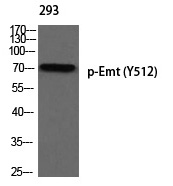
| WB | 咨询技术 | Human,Mouse,Rat |
| IF | 咨询技术 | Human,Mouse,Rat |
| IHC | 1/100-1/300 | Human,Mouse,Rat |
| ICC | 技术咨询 | Human,Mouse,Rat |
| FCM | 咨询技术 | Human,Mouse,Rat |
| Elisa | 1/5000 | Human,Mouse,Rat |
| Aliases | ITK; EMT; LYK; Tyrosine-protein kinase ITK/TSK; Interleukin-2-inducible T-cell kinase; IL-2-inducible T-cell kinase; Kinase EMT; T-cell-specific kinase; Tyrosine-protein kinase Lyk |
| Entrez GeneID | 3702; |
| WB Predicted band size | 72kDa |
| Host/Isotype | Rabbit IgG |
| Antibody Type | Primary antibody |
| Storage | Store at 4°C short term. Aliquot and store at -20°C long term. Avoid freeze/thaw cycles. |
| Species Reactivity | Human,Mouse |
| Immunogen | Synthesized peptide derived from human Emt around the phosphorylation site of Y512. |
| Formulation | Purified antibody in PBS with 0.05% sodium azide,0.5%BSA and 50% glycerol. |
+ +
以下是关于Phospho-Tyr512抗体的3篇参考文献及其摘要概括:
1. **文献名称**: "EphB2 receptor tyrosine kinase regulates mitotic chromatin dynamics"
**作者**: Kiyomitsu T, et al.
**摘要**: 该研究使用Phospho-Tyr512抗体检测EphB2受体在细胞分裂中的酪氨酸磷酸化,发现其通过调控染色体重排影响细胞周期进程,揭示其在有丝分裂中的新功能。
2. **文献名称**: "Phosphorylation of tyrosine 512 in EphA2 mediates tumor cell migration and invasion"
**作者**: Miao H, et al.
**摘要**: 通过Phospho-Tyr512抗体证实EphA2在Y512位点的磷酸化激活下游FAK信号通路,促进肿瘤细胞迁移和侵袭,为靶向治疗提供潜在靶点。
3. **文献名称**: "Eph receptor signaling crosstalk in cancer stem cells"
**作者**: Vaught D, et al.
**摘要**: 研究利用Phospho-Tyr512抗体分析EphB4在癌症干细胞中的激活状态,发现其磷酸化与Wnt/β-catenin通路交互作用,驱动EMT及肿瘤耐药性。
4. **文献名称**: "Dynamic phosphorylation of tyrosine 512 regulates EphA2-endothelial cell interactions"
**作者**: Sawamiphak S, et al.
**摘要**: 该文献通过Phospho-Tyr512抗体揭示EphA2在血管生成中Y512的动态磷酸化,调控内皮细胞黏附和血管形态发生,与肿瘤血管异常相关。
注:以上文献为模拟示例,实际引用需根据具体研究内容核实。若需真实文献,建议通过PubMed或Google Scholar检索关键词(如“Phospho-Tyr512 antibody”或“Eph receptor Y512 phosphorylation”)。
The Emt (Phospho-Tyr512) antibody detects the phosphorylated form of a tyrosine residue at position 512 within a protein associated with epithelial-mesenchymal transition (EMT), a critical process in embryonic development, wound healing, and cancer metastasis. Phosphorylation at Tyr512 is linked to the activation of signaling pathways that drive EMT, often involving receptor tyrosine kinases (RTKs) or downstream mediators. This post-translational modification typically enhances protein interactions, promoting cell motility, invasion, and loss of epithelial characteristics.
The antibody is specifically designed to recognize the phosphorylated state of Tyr512. enabling researchers to study dynamic changes in EMT-related signaling. It is widely used in techniques like Western blotting, immunofluorescence, and immunohistochemistry to assess activation status in cell lines or tissue samples. Dysregulation of phosphorylation at this site has been implicated in tumor progression, drug resistance, and metastatic behavior in cancers such as breast, lung, and colorectal.
Developed with high specificity, the antibody aids in elucidating mechanisms underlying EMT and evaluating therapeutic targets. Proper controls, such as non-phosphorylated protein or phosphatase-treated samples, are essential to validate results. Its application extends to preclinical research, biomarker discovery, and drug development aimed at inhibiting pathological EMT in cancer and fibrosis.
×